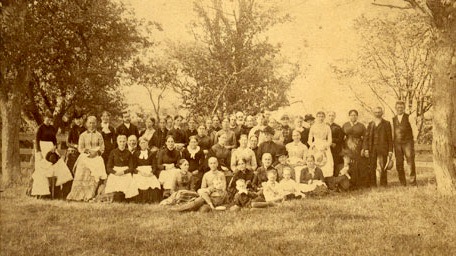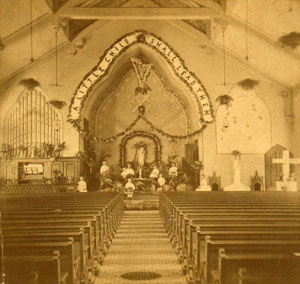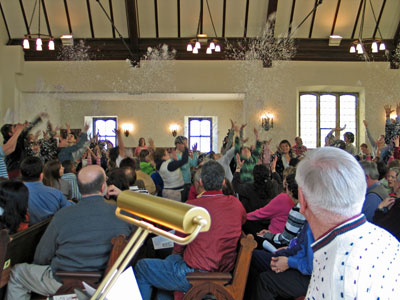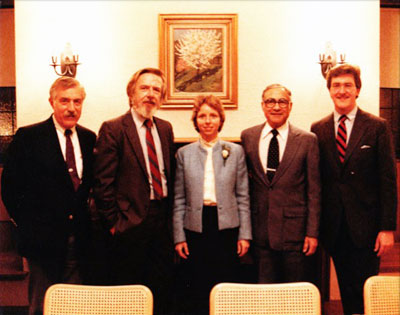Our History

(This written history is provided by UUCR’s Archives Committee.)
In 1823 certain members of Reading’s Third Parish Church desired to hear Unitarian preaching from their pulpit. They ultimately founded a church whose theology and social outlook has become ever more inclusive, and whose members and friends care deeply about each other and those around them. We are a church that stands on the side of love. The Unitarian Universalist Church of Reading is a welcoming place to:
Nurture and explore individual spirituality
Build a committed and loving community
Help heal the world
Our Beginnings
When Reading’s Third Parish Church (Congregational) called the Rev. Jared Reid as its new minister in 1823, religiously liberal members—stressing reason and personal experience over doctrinal authority—attempted a resolution that would occasionally bring Unitarian preachers to the pulpit. The motion was refused.
Within four years, 46 male members withdrew from the church, and on April 2, 1827 established the “Third Congregational Society of Reading” (Unitarian), with the purpose of “…promoting pure and evangelical principles of practical religion and morality.” During the next ten years, many eminent ministers visited the society and supplied its pulpit. For several of those years a resident minister was retained, but the society was small and by 1838 had no regular minister. About that time a few persons of Universalist bent were organizing a society. Since the purposes of the two groups were in most respects identical, in May of 1838 they merged and formed the “Second Universalist Society.”
The Liberal Ladies
The society disbanded in 1845, but the liberal movement in Reading lived on. On May 14, 1840, the women of the church had organized the Reading Association of Liberal Ladies for Benevolent and Useful Purposes—the “Sewing Circle.” By making and selling quilts, aprons, and pinafores, by binding shoes for Reading’s shoemaking trade, by holding to their motto “Happiness is a roadside flower growing on the highways of Usefulness,” in the short run they kept the liberal religious interest alive in Reading by obtaining the services of occasional lecturers and itinerant preachers. In the long run—for the circle existed into the 1920s—they were the model for the numerous auxiliary societies that flourished at the Reading church until well into the 20th century, creating community, gathering the church for social occasions, making charitable donations, and providing greatly needed funds for the church’s treasury.
Our Church Homes

To accommodate the congregation that swelled during the ministry of Rev. Edward Baxter Fairchild in the 1860s, the society built a lovely stone church in Reading Square, and in 1870 affiliated with the American Unitarian Association.
In 1909 began the church’s longest ministry–25 years of fellowship with Marion Franklin Ham, a poet and writer of hymns that appear in our hymnal and those of other denominations. By 1920 the congregation found the building in the Square inadequate, difficult to maintain, and poorly located (trolleys now rattled through the Square during Sunday services). They heeded Rev. Ham’s call to “rise up and build” and in 1924 dedicated the present church (to which they moved their pews, light fixtures, and organ), several blocks outside the Square.
Our Expanding Faith
Reflecting society at large, in the early 1970s the church wrestled with theology and the format of Sunday services—its growing religious liberalism becoming too liberal for some and not liberal enough for others. (With regard to giving teachers an outlined curriculum and a resource list, the RE Committee report for 1971-1972 notes that “Some feel this will help the new teacher. Others feel it may limit potential and flexibility.”)
In the early 1980s, recognizing our religious diversity and inclusivity, to the cross that hung alone next to our chancel archway we added the lamp of knowledge, the circle of eternity, the flaming chalice, the star of David, the sun sign of the Native Americans, and the Taoist yin/yang symbol. The symbols are movable and “do not presume to show all truth and wisdom” and can be added to or taken down. In 2004, the congregation discussed them again: symbols for Hinduism, Buddhism, Islam, and others were added.
Looking both beyond our doors and within ourselves, we’ve become a Welcoming Congregation. This initially meant ensuring that LBGTQ individuals are full members of our faith community, but it has grown to mean striving for radical inclusion and creating spaces that honor every part of human identities, backgrounds, and experiences. Our church hosts monthly meetings of the Reading chapter of PFLAG and we’ve flown the rainbow flag from our front portico for many years. Reading’s Diversity Awareness Steering Committee had its start in a Racism Awareness Group at the church. In 2015 UUCR was designated a Green Sanctuary, a church that engages in environmental practices and outreach.
Our Expanding Ministry
Our view of minister and ministry expanded during Rev. Dr. Jane Rzepka’s 15 years with us (1984–1999). UUCR became a Teaching Congregation during that time, one of our proudest roles, wherein a seminarian spends 2 years with our congregation, half-time in study and half-time as a ministerial intern embedded in the life of the church. A trained Pastoral Care Team began its supportive work. In 1999 our Sunday services started to reach the wider community through cable TV and on videotape/DVD to those physically unable to attend church. We created a website for increased access to newsletters and the monthly church calendar.

With a sanctuary past capacity on most Sundays and a new emphasis on including all ages in worship and congregational life, members and friends during the ministry of Rev. Tim Kutzmark donated over $2.1 million to the “Building Our Future” campaign to renovate and expand our facilities and add programs and staff. In September 2006, to accommodate construction, the congregation moved Sunday worship to nearby Parker Middle School. In April 2007, we returned to rededicate our expanded sanctuary, new Fellowship Hall, glass-covered atrium, large professional kitchen, and new office space. Our Director of Lifespan Religious Education became full-time, and our Choir Director’s role expanded to that of Music Director.
We’ve adopted a mission statement and (as ours is a congregation joined by covenant rather than creed) a relational covenant. In 2020, we began a Share the Plate program to donate half of each Sunday’s offering to a nonprofit organization aligned with our UU values, our Green Sanctuary team greatly expanded its environmental and environmental justice work to the community, and we started learning and discussion around issues of anti-oppression and anti-racism.
Our Living Tradition
Spirits faithful to liberal religion have moved forward in Reading since 1827. At times they had no minister, at times they had no church building, at times they changed denominations, and always their theology evolved. Yet fundamentally the line of forward-thinking, deeply caring souls has been unbroken since the early days—supporting a liberal pulpit, teaching the next generation, tending each other, governing and financing their enterprise—and we, their spiritual descendants, now move forward with joy, vigor, and sound purpose.
This history was updated on 3/28/2021
You may like to learn the history of our church’s ministers.

